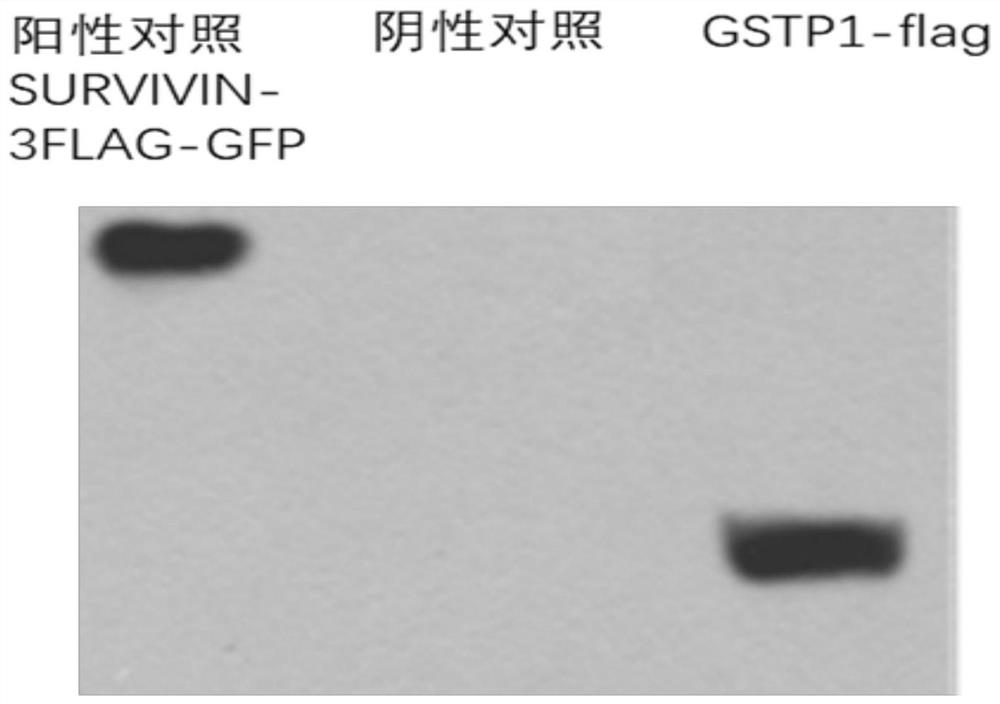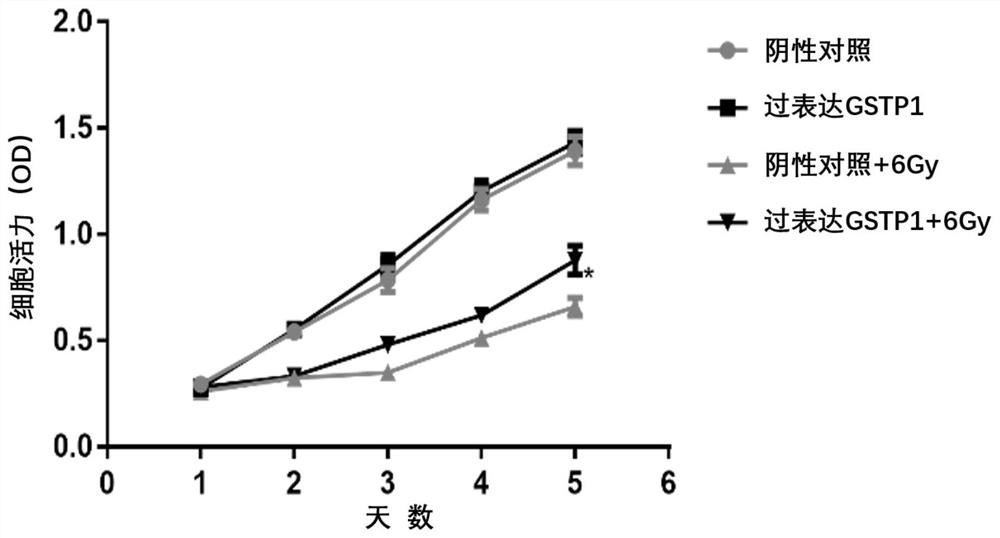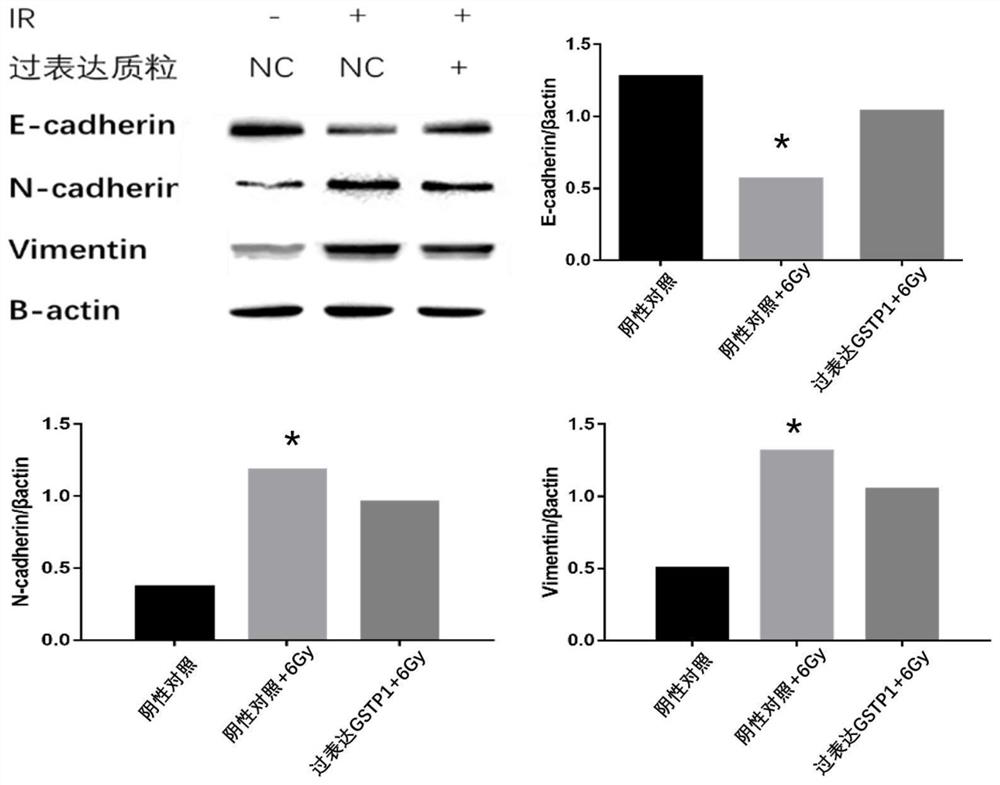Application of excited GSTP1 gene in medicine for preventing radioactive lung injury
A radiation-induced lung injury and drug technology, applied in the direction of drug combinations, medical preparations containing active ingredients, pharmaceutical formulas, etc., can solve the problems of no one reporting, etc., to reduce the damage and improve the effect of radiation-induced lung injury
- Summary
- Abstract
- Description
- Claims
- Application Information
AI Technical Summary
Problems solved by technology
Method used
Image
Examples
Embodiment 1
[0024] GSTP1 overexpression plasmid can significantly enhance GSTP1 protein in normal human lung epithelial cells:
[0025] experiment procedure:
[0026] (1) Cell culture: Culture BEAS-2B cells in LHC-8 medium and add penicillin at a final concentration of 100 U / mL and streptomycin (double antibody) at 100 μg / mL; place the cells at 37°C for 5 Culture in % CO 2 incubator, subculture once every 2-3 days, and take logarithmic growth phase cells for experiments.
[0027] (2) Cell transfection: BEAS-2B was inoculated in a 35 mm diameter petri dish, each dish was inoculated with 3×10 5 cells, and cultured for 24 hours. Avoid antibiotics during plating and transfection. Preparation of transfection solution: The dosage ratio of plasmid: Lipofectamine2000 is 4 μg / well: 10 μl / well. Add the prepared transfection solution into the BEAS-2B cell culture dish to be transfected, and place the culture dish in an incubator for incubation. After 6 hours, the culture medium containing the tr...
Embodiment 2
[0032] The expression of GSTP1 had no effect on cell proliferation. Under radiation stress, the cell proliferation activity of the overexpression group was higher than that of the empty plasmid transfection group (P<0.05):
[0033] experiment procedure:
[0034] (1) Cell culture and cell transfection are the same as in Example 1;
[0035] (2) MTT experiment method: Digest and count BEAS-2B cells in the logarithmic growth phase, resuspend the cells to make the cell concentration 6x104 cells / ml, absorb 200 μl of the cell suspension, and inoculate the cells into a 96-well plate, 37 ℃ incubator incubation. Add 20 μl of working concentration MTT solution (0.5 mg / ml) to each well of the 96-well plate, incubate in the incubator for 4 hours, and then take it out. Discard the culture medium, add 150 μl DMSO to each well, and use a microplate reader (490 nm wavelength) to detect after 10 min.
[0036] Experimental results:
[0037] by right figure 2The growth and proliferation cha...
Embodiment 3
[0039] Enhance the expression of GSTP1 gene, inhibit the occurrence of cell EMT process caused by radiation and weaken the cell damage caused by radiation:
[0040] experiment procedure:
[0041] (1) Cell culture and cell transfection are the same as in Example 1;
[0042] (2) Take BEAS-2B cells transfected with GSTP1 overexpression plasmid and negative control plasmid for 48 hours in the logarithmic growth phase, extract protein, and perform Western blot electrophoresis. Expose the bands of GSTP1, N-cadherin, Vimentin, E-cadherin and β-ACTIN using an exposure instrument.
[0043] Among them, the irradiation conditions: 60Coγ-ray irradiation of the Academy of Military Sciences. Cells were treated with 6Gy of γ-ray irradiation at a dose rate of 1Gy / min.
[0044] Experimental results:
[0045] Statistical processing: All the experiments in the above examples were repeated more than 3 times, and SAS statistical software was used to perform t-test on the relevant data, and P<0...
PUM
 Login to View More
Login to View More Abstract
Description
Claims
Application Information
 Login to View More
Login to View More - R&D Engineer
- R&D Manager
- IP Professional
- Industry Leading Data Capabilities
- Powerful AI technology
- Patent DNA Extraction
Browse by: Latest US Patents, China's latest patents, Technical Efficacy Thesaurus, Application Domain, Technology Topic, Popular Technical Reports.
© 2024 PatSnap. All rights reserved.Legal|Privacy policy|Modern Slavery Act Transparency Statement|Sitemap|About US| Contact US: help@patsnap.com










